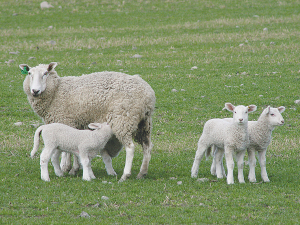Turning data into dollars
If growing more feed at home adds up to $428 profit per tonne of dry matter to your bottom line, wouldn’t it be good to have a ryegrass that gets you there quicker?
 Lambs born to well-fed ewes will have energy stored as fat reserves and are better able to survive adverse times.
Lambs born to well-fed ewes will have energy stored as fat reserves and are better able to survive adverse times.
Maintaining ewes in good body condition and the provision of shelter are two important management factors in maximising this year’s lamb crop.
While scanning percentages are back in many regions due to dry conditions and feed shortages, Will Halliday – Beef + Lamb New Zealand’s senior advisor for animal welfare – says the focus will be on minimising wastage between scanning and tailing.
While this country’s temperate climate allows farmers to operate world class, grass-based outdoor farming systems, which have significant animal health and welfare benefits, adverse weather is inevitable. But there are several measures farmers can take to minimise the impact of weather on livestock, particularly over lambing and calving.
Feeding is the most critical factor. Lambs born to well-fed ewes will have energy stored as fat reserves and are better able to survive times of reduced feed such as during windy or wet conditions or in extreme weather.
A well-fed ewe is considered the best shelter a lamb can have. However, protecting ewes from bad weather by providing shelter before lambing will contribute significantly to the chances of good lamb birthweights and survival.
Lambs from a ewe with Body Condition (BCS) of below 3 have poorer vigour and take longer to stand.
While the ewe is less interested in her lamb and has a poorer developed udder.
Lamb survival falls by 5% for every half a BCS lost between scanning and lambing.
Wind-chill is a major threat to livestock welfare and lamb survival.
The ambient temperature experienced by a new-born lamb depends on the air temperature and wind-chill which is directly determined by wind speed. The greater the wind-chill, the greater an animal’s heat loss.
Any type of shelter slows the wind speed and reduces wind-chill. Critical extra minutes of a lamb’s life may be gained by providing shelter, during which time a ewe could return to her lamb after lambing and get it to suckle.
This shelter may include trees, hedges, bushes, tussocks or rocks, although topography, slope, aspect and microclimate also play a role and some paddocks can be sheltered without any vegetation.
Multiple lambs are typically lighter lambs. These lambs are more vulnerable to heat loss as they have lower fat reserves than heavier lambs and a higher surface area to bodyweight ratio, increasing heat loss.
Providing shelter for ewes known to be carrying multiple lambs should be a priority both to protect the ewes before lambing and give lambs a better chance of survival once born.
In extreme weather, even well fed, well bonded lambs may succumb to extreme cold, and weak lambs can be given a 20% mix of Dextrose (Dextrose differs from table sugar and can be sourced from homebrew shops or supermarkets) directly into the abdomen. This can give the lamb the energy boost it needs to survive.
Orphan lambs are inevitable, irrespective of the weather.
There are several resources on rearing orphan lambs on the B+LNZ website.
More than 150 people turned up at Parliament recently to celebrate the 20th anniversary of Horticulture New Zealand (HortNZ).
Biosecurity New Zealand says Kiwis should continue to keep an eye out for yellow-legged hornets (Vespa velutina) over the holiday season.
The Push-Up Challenge, an event which combines mental health and fitness, is set to launch in New Zealand in 2026.
Last month's Agritechnica event led to a wide group of manufacturers celebrating successes when the 2026 Tractor of the Year Competition winners, selected by a panel of European journalists, were announced in Hanover Germany.
According to the latest Federated Farmers banking survey, farmers are more satisfied with their bank and less under pressure, however, the sector is well short of confidence levels seen last decade.
Farmer confidence has taken a slight dip according to the final Rabobank rural confidence survey for the year.

OPINION: The release of the Natural Environment Bill and Planning Bill to replace the Resource Management Act is a red-letter day…
OPINION: Federated Farmers has launched a new campaign, swapping ‘The Twelve Days of Christmas’ for ‘The Twelve Pests of Christmas’ to…